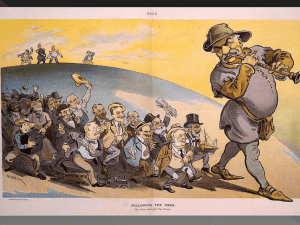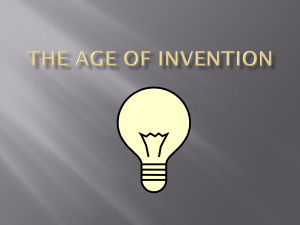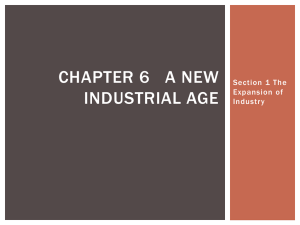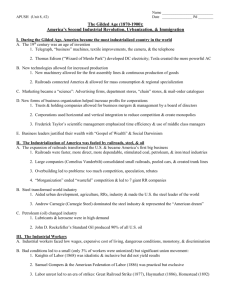U.S. History Chapter 5, Section 2
advertisement
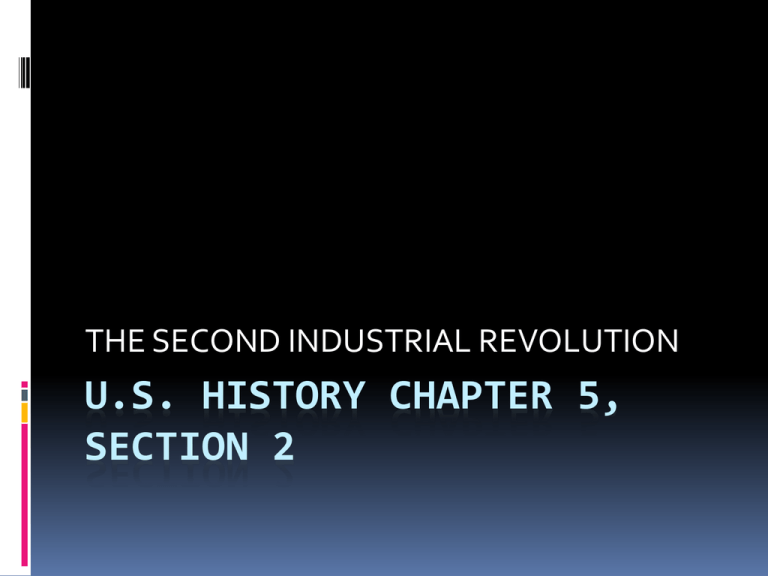
THE SECOND INDUSTRIAL REVOLUTION U.S. HISTORY CHAPTER 5, SECTION 2 The Second Industrial Revolution INTRODUCTION: During the late 1800’s, new technology and inventions led to growth in industry and big business, and revolutions in transportation and communication. OIL BOOM In the mid-1800’s people refined oil into kerosene to light lamps In 1859 in Pennsylvania, Edwin L. Drake drilled into the ground to extract oil – soon he was pumping oil to the surface “Wildcatters” – oil prospectors OIL BOOM (continued) In 1901 oil was found near Beaumont, Texas – this led to an “oil boom” in Texas Many leading oil companies started here, and later they would refine crude oil into gasoline and other petroleum products, creating a revolution in transportation and industry INDUSTRY New technology in oil and steel industries MAKING STEEL: in the 1850’s a new method, called the “Bessemer process,” made steel making faster and cheaper American steel mills: 1873: 115,000 tons 1910: 24 million tons RAILROADS In the 1850’s, railroads crisscrossed the Northeast and into the Southeast and Great Lakes region Congress authorized two companies to build rail lines to the West Coast: Union Pacific westward from Omaha; Central Pacific eastward from Sacramento May 10, 1869 the two lines met at Promontory Summit in Utah Territory Railroads… -Government gave land -Cheap steel enabled expansion -Promoted trade and provided jobs -Sped up settlement of the West -Caused new towns to spring up -Led to standardized time for the nation (1918) THE RISE OF BIG BUSINESS Big business prospered in the 1800’s Entrepreneurs: risk takers who started new business ventures Capitalism: economic system in which business is privately owned Laissez-faire capitalism: companies operating without government interference Social Darwinism: the stronger survive New Business Organizations New type of business organization: Corporation – a business with the legal status of an individual; business owned by people who buy stock, or shares, in the company Board of Directors – make decisions Corporate Officers – run operations Monopoly: business having complete control over an industry Industrial Tycoons John D. Rockefeller: Standard Oil started in oil refinery business – by 1875 Standard Oil refined half the oil in the U.S. Andrew Carnegie: poor boy – went to work for the railroads – invested – founded his own company, Carnegie Steel Company, and by 1899 dominated the steel industry (sold his company in 1901 for $480 million) Industrial Tycoons (con’t) Cornelius Vanderbilt Began investing in railroads during the Civil War George Pullman made a fortune designing and building railroad sleeper cars Industrial Tycoons (con’t) TWO VIEWS: 1) “Robber Barons” who destroyed competitors with tough tactics 2) “Captains of Industry” who used their business skills to expand and strengthen the national economy Working Conditions late 1800’s Steelworkers: worked 12 hours a day, six days a week, for little pay Textile workers: worked 60 – 80 hours per week (many of them were children) Miners: worked underground with explosives, but without safety regulations Low pay, unhealthy conditions, no sick pay or leave, no compensation for injuries Management and Labor They had differing opposing interests – workers wanted good wages; owners wanted to keep labor costs low There was a great gap between rich and poor. The relationship became strained – conflict! Workers began forming Unions Workers began to organize By the late 1800’s workers began to band together to pressure employers for better pay and working conditions KNIGHTS OF LABOR (1869) – campaigned for an 8-hour workday, end of child labor, and equal pay for equal work This was the beginning of the LABOR UNION Unions STRIKE! GREAT RAILROAD STRIKE (1877): Workers struck in protest against wage cuts – blocked movement of trains – strikes spread – clashes led to many deaths – Army finally ended the strike HAYMARKET RIOT (1886): about 1,500 different strikes over wage cuts – in Chicago crowds gathered, a bomb went off, 11 died and more than 100 were injured “Solidarity Forever” When the union's inspiration through the workers' blood shall run, There can be no power greater anywhere beneath the sun; Yet what force on earth is weaker than the feeble strength of one, But the union makes us strong. CHORUS: Solidarity forever, Solidarity forever, Solidarity forever, For the union makes us strong. It is we who plowed the prairies; built the cities where they trade; Dug the mines and built the workshops, endless miles of railroad laid; Now we stand outcast and starving midst the wonders we have made; But the union makes us strong. Chorus. They have taken untold millions that they never toiled to earn, But without our brain and muscle not a single wheel can turn. We can break their haughty power, gain our freedom when we learn That the union makes us strong. Setbacks for organized labor Employers tried to get employees to sign pledges to not join unions – In 1886 a group of workers, led by Samuel Gompers, formed the American Federation of Labor (AFL) – they won wage increases and shorter workweeks Though gains were made, yet the late 1800’s remained the era of “big business” Workers: Organize & Strike Advances in Transportation Railroads made long-distance travel easier A transportation revolution: STREETCARS: by 1900 most cities had electric streetcars SUBWAYS: Boston opened the first subway line in 1897; New York in 1904 AUTOMOBILES: first practical American motorcar in 1893 AIRPLANES: Wright brothers first flew December 17, 1903 Mass Marketing Retail merchants looking for ways to maximize their profits – new forms of marketing (brand names, advertising) “DEPARTMENT STORE” Many items in one store Mail-order purchasing Advances in Communication TELEGRAPH: 1837 Samuel Morse patented method for sending messages over wires Wires came to be strung on poles along railroad tracks TELEPHONE: Alexander Graham Bell patented a design in 1876 – by 1900 there were more than a million telephones in offices & homes TYPEWRITER: first practical typewriter developed in 1867 – women hired as typists Thomas Edison One of America’s most amazing inventors: in 1876, Thomas Alva Edison opened a research lab in New Jersey – spent hours testing ideas – invented first phonograph; telephone transmitter; electric light bulb; electricity network to New York City; electric power plants… (more than 1,000 U.S. patents!) An Age of Extremes: Great individual wealth and terrible poverty New factory jobs and corporations New inventions: Electric lights Horseless carriages Telephones Flying machines Moving pictures Skyscrapers Record players Typewriters Baseball & Football leagues


